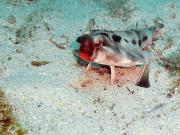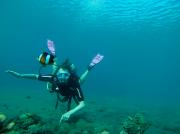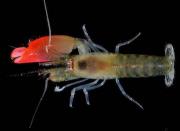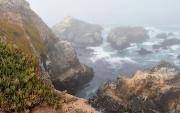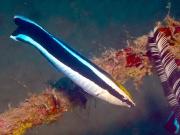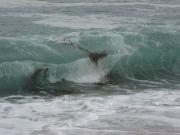Radio Program
Our regular Science and the SeaTM radio program presents marine science topics in an engaging two-minute story format. Our script writers gather ideas for the radio program from the University of Texas Marine Science Institute's researchers and from our very popular college class, Introduction to Oceanography, which we teach to hundreds of non-science majors at The University of Texas at Austin every year. Our radio programs are distributed at to commercial and public radio stations across the country.
If a modern-day Hollywood creature designer worked with a 1940s make-up artist, they might come up with something that’s shaped a little like a bat, walks on the ocean floor, and has gaudy red lips. In other words, they’d make a red-lipped batfish -- an odd critter that lives on reefs around the Galapagos Islands, which are off the Pacific coast of South America.
When many people see a dark shadow passing through the water close to shore, they think of one thing: Jaws. Is it a shark, ready to attack unsuspecting swimmers and surfers?
On the beaches of eastern Australia, it’s probably not. Researchers used drones to shoot video along four beaches. And they found that sharks were a rare sight.
Drones are becoming popular tools for marine scientists. The birds-eye view can help them count animals, study water quality and red tides, and perform many other tasks.
Mangrove forests are some of the most important on the planet. They protect the coastline from storms and provide habitat for fish and other creatures.
Some of the most amazing colors on Earth are seen in icebergs and their parent bodies, glaciers. The intense shades of blue and blue-green make them look like icy confections -- like sno-cones flavored with blueberry or mint syrup.
These masses of ice are colored blue for the same reason as the water in the oceans. Water molecules are just the right size to absorb the longer, redder wavelengths of light. But they allow the shorter, bluer wavelengths to pass through, or to scatter like blue jellybeans dropped on a hardwood floor.
The guitarfish looks a bit like the result of an experiment by a junior mad scientist. The front half is wide and flat, like a sting ray. But the back half is long and tapered, like a shark. Put the two halves together, and look at them from above or below, and the outline resembles a stringed instrument. So the creature is called a guitarfish, although it’s also known as a fiddler ray or a banjo shark.
Tropical cyclones are a fact of life on the islands of southeast Asia. Among other things, they can damage reef systems that attract divers and other tourists, harming local economies. How people and institutions handle that challenge can determine how quickly they recover.
This idea is known as adaptive capacity. It’s the ability to absorb shocks, recover and learn from them, and apply those lessons to make things better.
The pistol shrimp has terrible eyesight. But some species of the shrimp get help -- not spectacles, but a companion fish: a goby. It keeps an eye out for predators. In turn, the shrimp maintains a burrow that’s used by both of them.
The pistol shrimp gets its name from one of its claws, which is larger than the other. It snaps the claw shut quickly, generating bubbles. When the bubbles collapse, they produce a loud sound -- like a gunshot. That can stun prey, and allow the shrimp to communicate with other shrimp around it.
Bodega Bay is best known for its birds. Not real birds, but the scary ones from a movie: Alfred Hitchcock’s “The Birds.” The film was set and shot in the village of Bodega Bay, California, up the coast from San Francisco.
We might not always think so, but people who spend time preening in a mirror are actually passing an intelligence test -- showing an awareness that the thing in the mirror is them. Only a few other species have shown this level of self-awareness, including dolphins and elephants. The most recent addition to the list is a fish that was already known to be pretty smart.
A calm day on the beaches of the Pacific Northwest can turn deadly in a hurry. A single large wave can rush ashore, running inland up to 50 yards farther than the previous waves. Anyone who’s too close can be washed into the ocean. In fact, more than two dozen beachgoers have been killed by such waves in the last decade and a half.

